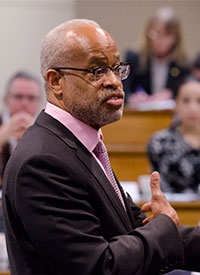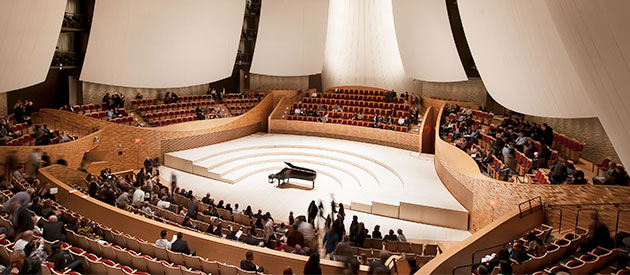Annual Report 2012
Education in the 21st Century — Evolution and Revolution
by President John Hennessy
 President John Hennessy
President John Hennessy
For Stanford University, 2012 was marked by significant academic developments, two Nobel Prizes and fundraising records, both in amount raised and level of participation.
It was a year of academic evolution and revolution, when we built on our solid foundation and began reimagining the Stanford educational experience in the 21st century. Innovative updates to our undergraduate curriculum and the launch of Stanford Online, with its path-breaking experiments in online education, strengthened the academic mission.
The university’s last comprehensive look at undergraduate education was the Commission on Undergraduate Education (CUE) in 1993-94, which transformed the undergraduate experience at Stanford. Both the world and the university have changed in the intervening decades, and it was time to revisit the undergraduate curriculum.
In January 2010, when Provost John Etchemendy and then-Vice Provost for Undergraduate Education John Bravman launched the Study of Undergraduate Education at Stanford (SUES), they asked committee members to consider: “What do we want our students to gain from their time on the Farm? How do we best prepare them for local, national and global citizenship?”
 The Study of Undergraduate Education contains 55 recommendations
The Study of Undergraduate Education contains 55 recommendations
The SUES committee delivered its report in early 2012. Among its most salient outcomes was a continued strong commitment to liberal education for all students. Although many colleges and universities are moving away from that approach, Stanford’s faculty believe strongly that a liberal education is the best preparation for a complex and rapidly moving world that quickly makes obsolete an education focused on short-term skills. “Thinking Matters” courses, organized around big life questions or societal problems, introduce freshmen to the critical-thinking and problem-solving skills that Stanford seeks to develop in students. Many of the distinctive curricula arising from the 1990s CUE report were maintained: the foreign language requirement, a sequence in writing and rhetoric, and the small group seminars that give our newest students opportunities to work closely with faculty. The breadth requirements were revised to reflect a broader definition of the experience the faculty believe students should have, and these requirements include new classes in moral and ethical reasoning and in creative thinking.
If the SUES report reflected an evolution in our thinking about undergraduate education, revolution better describes our ventures in online education. Online education has the potential to change the way education is delivered for a significant number of students — and no university is better equipped to be a pioneer in this field than Stanford, with its history of using technology for graduate and professional education.
We believe the impact of online education could be profound. Over the course of this year, we have examined how the new online technologies can help us extend our educational mission: how we can better educate our existing students, and also how we might disseminate knowledge more broadly to reach students we cannot accommodate today and to help schools worldwide through online delivery of courses.
 John Mitchell was appointed as Stanford’s new vice provost for online learning
John Mitchell was appointed as Stanford’s new vice provost for online learning
We launched the Stanford Online initiative and created the Office of the Vice Provost for Online Learning to address these issues. John Mitchell, the Mary and Gordon Crary Family Professor in the School of Engineering, was appointed Stanford’s first vice provost for online learning. Over the past year, he has worked with the faculty on the many issues involved in emerging educational technology.
The technology is in its infancy, and this is a time of great experimentation in both online courses and the platforms on which they are offered. Last fall, Stanford faculty offered more than a dozen online courses in engineering, mathematics, social sciences, education and entrepreneurship; many more will be offered in winter and spring. As courses are developed, faculty can choose among several software platforms that offer different features.
Coursera, founded by Daphne Koller and Andrew Ng, Stanford computer science professors who are currently on leave, has been well received and currently has more than 30 university partners worldwide. Class2Go, a nonprofit, open-source platform, was launched in September. Designed by Stanford engineers in the Department of Computer Science, Class2Go is both a teaching and research platform, giving faculty the ability to conduct research about online learning as they teach. Venture Lab, developed by Amin Saberi, associate professor of management science and engineering at Stanford, emphasizes team-based learning. For example, a fall online course in technology entrepreneurship offered on Venture Lab enrolled over 150,000 students from more than 100 countries. Taught by Chuck Eesley, assistant professor of management science and engineering, the course focused on experiential learning, with students forming virtual teams to develop product visions, work on business plans and create prototypes.
 Vice Provost Harry Elam leads Stanford's undergraduate curriculum efforts
Vice Provost Harry Elam leads Stanford's undergraduate curriculum efforts
Our goal with all of these experiments is to enhance the quality of the education we provide and to leverage the technology available to us. We understand that online education will not be appropriate for every situation. But we believe it will be instrumental in how we pursue our mission in this century.
Stanford also celebrated two Nobel Prizes this fall. Brian Kobilka, MD, professor and chair of molecular and cellular physiology at the School of Medicine, was awarded the 2012 Nobel Prize in Chemistry for his groundbreaking work on G-protein-coupled receptors (GPCRs), a topic he has worked on for about 25 years. GPCRs regulate heartbeat, brain function and other essential physiological processes; understanding them is critical for effective pharmaceutical therapies. Professor Kobilka shares the Nobel with Robert Lefkowitz of the Howard Hughes Medical Institute and Duke University Medical Center.
Alvin Roth was the McCaw Senior Visiting Professor of Economics at Stanford when he learned he had been awarded the Nobel Memorial Prize in Economic Sciences for his work in market design. A Harvard economist and Stanford alumnus who will join our faculty in 2013, Professor Roth is a pioneer in game theory known for his innovations in matching theory, which have been applied to kidney exchanges, how medical residents are matched with hospitals and systems for public school choice. He shares the prize with Lloyd Shapley, professor emeritus at the University of California-Los Angeles.
As we begin 2013, we will see significant advances in the progress of the arts district. Our world-class performing venue, the Bing Concert Hall, will open in January. Its inaugural season will feature performances by pianist Emanuel Ax, cellist Yo-Yo Ma with pianist Kathryn Stott, violinist Midori, the Mingus Big Band, Los Lobos and many more. Last October, we broke ground for the new building that will hold the Anderson Collection at Stanford University and look forward to its opening in 2014.
In addition to advances in our academic mission and recognition for the pioneering work of our faculty, last year was a record year in fundraising: $1.035 billion was received from nearly 79,000 donors who — through their gifts — ensured that the innovations for which Stanford is known will continue into the future. Their philanthropic investments help make groundbreaking research possible, support much-needed improvements in our hospital and keep Stanford accessible to the brightest students. Their support is a tremendous vote of confidence in our faculty and our students.
Since its founding, Stanford University has sought to be a “university of high degree.” The events of this year are landmark steps in educating the next generation of leaders, and they herald new ways of advancing our mission in the coming years.
 The Bing Concert Hall
The Bing Concert Hall